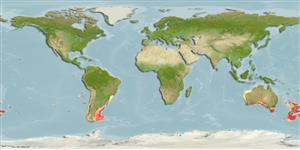>
Gadiformes (Cods) >
Macruronidae (Blue grenadiers)
Etymology: Macruronus: Greek, makros = great + Greek, onos = hake.
Environment: milieu / climate zone / ระดับความลึก / distribution range
นิเวศวิทยา
เกี่ยวกับทะเล,น้ำเค็ม; กร่อย กลุ่มสัตว์หน้าดิน,กลุ่มสัตว์พื้นท้องน้ำ; สัตว์น้ำที่อาศัยและอพยพภายในทะเลเท่านั้น; ระดับความลึก 0 - 1000 m (Ref. 26566), usually 200 - 700 m (Ref. 9563). Subtropical; 15°S - 55°S, 111°E - 173°W (Ref. 58452)
Southwest Pacific: New Zealand and southern Australia.
Length at first maturity / ขนาด / น้ำหนัก / Age
วัยเจริญพันธุ์: Lm 67.5, range 65 - 70 cm
Max length : 120 cm TL เพศผู้/กระเทย; (Ref. 1371); 130.0 cm TL (female); common length : 80.0 cm TL เพศผู้/กระเทย; (Ref. 1371); น้ำหนักสูงสุดที่มีการรายงาน: 1.5 kg (Ref. 1371); น้ำหนักสูงสุดที่มีการรายงาน: 1.5 kg; อายุสูงสุดที่ได้รายงาน: 25 ปี (Ref. 6390)
Short description
เครื่องมือที่ใช้ในการแยกชนิดสัตว์,สิ่งมีชีวิตออกจากกัน | สัณฐานวิทยา | ความยาวต่างๆ
เงี่ยงครีบหลัง (รวม) : 12 - 13; ก้านครีบอ่อนที่หาง (รวม) : 96 - 106; เงี่ยงครีบก้น: 0; ก้านครีบอ่อนที่ก้น: 89 - 93; สัตว์มีกระดูกสันหลัง: 78 - 81. Dorsal surface silvery, with a purple or blue-green tinge; plank and belly silvery; fins darker. Body very elongate and compressed with a tapering tail, dorsal and anal fins confluent with the caudal fin (Ref. 33856).
Body shape (shape guide): elongated; Cross section: oval.
Appear to live usually on or near the bottom, but may occasionally move up into mid-waters. Large adult fish generally occur deeper than 400 m, while juveniles may be found in shallower water (Ref. 9072), more commonly found in large estuaries and bays, and may even enter freshwaters (Ref. 1371). Juvenile specimens and especially adults belonging to the American subspecies, have been caught from the coastal zone to 110 m (Ref. 58452). Form schools. Feed primarily on lantern fishes. In New Zealand, it feeds in midwater on small fish, crustaceans and squid. Oviparous, spawn 1 million eggs on the average which are released all at one time (Ref. 6390). Utilized fresh and frozen; can be steamed, fried, cooked in microwave and baked (Ref. 9988).
Female blue grenadier produce about 1 million eggs on average, which are all released at once (Ref. 6390).
Cohen, D.M., T. Inada, T. Iwamoto and N. Scialabba, 1990. FAO species catalogue. Vol. 10. Gadiform fishes of the world (Order Gadiformes). An annotated and illustrated catalogue of cods, hakes, grenadiers and other gadiform fishes known to date. FAO Fish. Synop. 125(10). Rome: FAO. 442 p. (Ref. 1371)
IUCN Red List Status (Ref. 130435: Version 2025-1)
Threat to humans
Harmless
Human uses
การประมง: เน้นการพาณิชย์
เครื่องมือ
Special reports
Download XML
แหล่งที่มาจากอินเตอร์เน็ต
Estimates based on models
Preferred temperature (อ้างอิง
123201): 5.8 - 12.5, mean 8 °C (based on 300 cells).
Phylogenetic diversity index (อ้างอิง
82804): PD
50 = 0.6250 [Uniqueness, from 0.5 = low to 2.0 = high].
Bayesian length-weight: a=0.00389 (0.00221 - 0.00684), b=2.97 (2.80 - 3.14), in cm total length, based on LWR estimates for this species & (Sub)family-body (Ref.
93245).
ระดับชั้นอาหาร (อ้างอิง
69278): 4.5 ±0.2 se; based on diet studies.
Generation time: 6.1 (5.2 - 8.9) years. Estimated as median ln(3)/K based on 18
growth studies.
ความสามารถในการกลับคืนสู่ปกติ (อ้างอิง
120179): ต่ำ, เวลาต่ำสุดที่จะทำให้ประชากรเพิ่มขึ้นเป็น 2 เท่าใช้เวลา 4.5 - 14 ปี (K=0.12-0.2; tm=3-7; tmax=25; Fec = 1,000,000).
Prior r = 0.29, 95% CL = 0.19 - 0.44, Based on 3 full stock assessments.
Fishing Vulnerability (Ref.
59153): High to very high vulnerability (66 of 100).
🛈
Climate Vulnerability (Ref.
125649): High vulnerability (61 of 100).
🛈
Nutrients (Ref.
124155): Calcium = 26.4 [12.3, 56.9] mg/100g; Iron = 0.629 [0.299, 1.299] mg/100g; Protein = 17.7 [15.5, 19.8] %; Omega3 = 0.224 [0.105, 0.456] g/100g; Selenium = 62.1 [26.1, 122.9] μg/100g; VitaminA = 17.2 [5.4, 54.1] μg/100g; Zinc = 0.541 [0.348, 0.866] mg/100g (wet weight); based on
nutrient studies.
